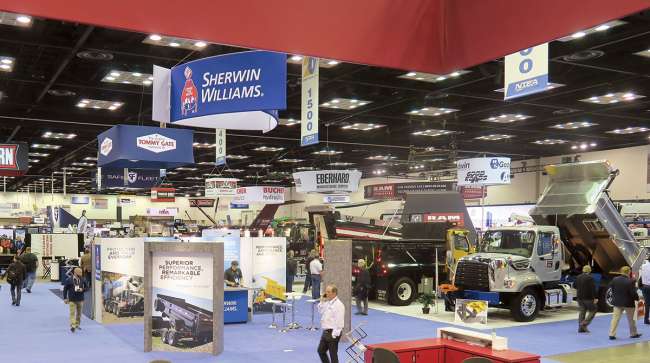Staff Reporter
IHS Expects Trucking Recovery Despite Concerns in 2021

[Stay on top of transportation news: Get TTNews in your inbox.]
Trucking is likely to see strong gains this year, but risks remain as the economy tries to leave the coronavirus behind, according to IHS Markit.
The economy soon could be impacted by a third stimulus bill and the growing number of people who are vaccinated. IHS Markit, a provider of global market, industry and technical information, expects these trends to help the economy expand year-over-year by as much as 5.7% in 2021.
“We’ve become more optimistic on our view on the economy,” Andrej Divis, director of global heavy-truck research at IHS Markit, said during a virtual presentation March 9. “We see strong gains and consumer spending, even exceeding the top-line [gross domestic product] numbers. Obviously, this is going to drive freight. That’s a healthy sign for our industry.”

Divis
The NTEA, The Association for the Work Truck Industry, hosted the presentation as part of its Work Truck Week 2021. Divis also said during the presentation that he expects further investments in freight and other industries across the economy.
“The truck orders that we’ve been seeing in our industry in the last four or five months, that’s been true in other industries,” he said. “Other industries are also seeing strong capital goods orders. We see that driving investment in the U.S. economy overall for the foreseeable future, and also imports and exports are expected to recover sharply in 2021.”
Divis warned there are some caveats and uncertainties that could negatively impact that outlook. The most obvious is the coronavirus pandemic continuing to represent downside risks.
“The new cases per day are certainly dropping,” he said. “Vaccines are getting rolled out, and we’re cautiously optimistic that the economy will be much more opened up in the summer than it has been pretty much since the beginning of the COVID epidemic.
We see strong gains and consumer spending … Obviously, this is going to drive freight.
Andrej Divis, director of global heavy-truck research at IHS Markit
“Having said that, there are, of course, uncertainties. There are new variants that are out there. It’s unclear how quickly they’re going to spread in the United States. It’s unclear how those are going to interact with the vaccines over time.”
Divis added that another factor he has been assessing is the strength of e-commerce in 2020. He sees that trend continuing for the first two quarters of this year. But then he expects it to slow in the second half as more people resume on services such as restaurants, hotels, events and travel.
IHS Markit: Strong Economy to Drive Demand for Class 8 Registrations #wtw21 https://t.co/F6oC2zjM86 — The Work Truck Show (@WorkTruckShow) March 9, 2021
“E-commerce helped to support freight, avoiding a larger collapse in Class 8 that would have otherwise been the case,” Divis said. “We’re not anticipating a reversal of the growth, but we are anticipating a sharp slowdown as people start spending money on other things like services. This will be a bit of a headwind to truck sales, sort of balancing some of the other strengths.”
IHS reported that Class 8 registrations dropped to 197,000 in 2020 compared with 269,000 the year before. But that is expected to recover to 226,000 by the end of the year. Registrations are expected to climb to 231,000 in 2022 before dropping off again.
“We’ve seen a sharp recovery in truck sales at the back half of 2020 and in early 2021,” Divis said. “I can tell you that so far that recovery has been mostly driven by replacements as opposed to capacity expansion by fleets.
“However, as we get into 2021 with those expected economic growth rates, some capacity expansion is going to be necessary to handle that level of economic activity. And so that’s one of the signposts that we would be looking for.”

Fleets are investing in tech-based safety tools that inform and forewarn potential risk. But how do they condition and prepare drivers to respond to safety alerts? Find out as the RoadSigns Team speaks with Tom DiSalvi, VP of safety at Schneider National, and Charlie Mohn, director of product innovation at Drivewyze. Hear a snippet, above, and get the full program by going to RoadSigns.TTNews.com.
He added that larger fleets played a smaller role in the truck market — compared with smaller fleets — than they usually do in 2020. But he sees larger fleets getting back into the market in a big way this year. There already have been signs of that with a lot of the orders placed in recent months being by larger fleets.
“That’s going to be another signpost that we’re going to look for to confirm that we’re on a strong upswing,” Divis said. “There are questions right now about the supply chain, and that really has to do with a couple of things. I think COVID is obviously an important part of it, but there is a question on a semiconductor shortage and we know that’s affecting some light-truck plants.”
He has not heard about the same kinds of issues on the medium- and heavy-duty truck side so far, but that could change.
“The other supply chain issue is really the fact that when we look at 2020, production, in general, got cut for Classes 4 to 8 a lot more than demand,” Divis said. “So to really achieve the upside for demand, production is going to have to ramp up much more quickly than demand for a period of time. And it remains to be seen if that can be done.”
Want more news? Listen to today's daily briefing below or go here for more info:

